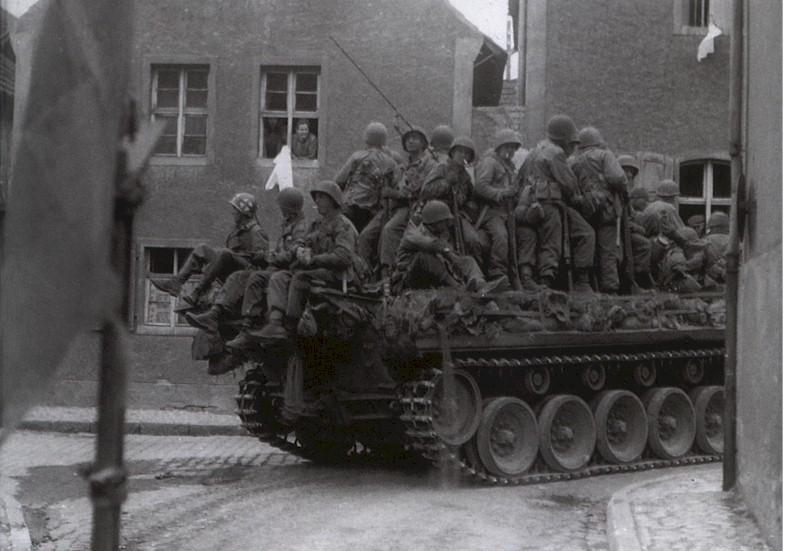 The story of the 83rd continues even though Uncle Rolland was evacuated on 22 January 1945.
After a refit in Belgium during the month of February, the 83rd prepared for its
next assignment: The race to the Rhine River, the last major obstacle to the
German heartland. The 83rd went on to fame when they crossed the
Roer River and raced to the Rhine River, reaching it in only 17 1/2 hours after
being committed. Once the Rhine area was secured it was time for the 83rd to
train for a river crossing in preparation for an assault across the Rhine.
Once they crossed the Rhine the 83rd raced to meet the Russians at the Elbe river and were
only 65 miles of Berlin when they were ordered to stop.
The story of the 83rd continues even though Uncle Rolland was evacuated on 22 January 1945.
After a refit in Belgium during the month of February, the 83rd prepared for its
next assignment: The race to the Rhine River, the last major obstacle to the
German heartland. The 83rd went on to fame when they crossed the
Roer River and raced to the Rhine River, reaching it in only 17 1/2 hours after
being committed. Once the Rhine area was secured it was time for the 83rd to
train for a river crossing in preparation for an assault across the Rhine.
Once they crossed the Rhine the 83rd raced to meet the Russians at the Elbe river and were
only 65 miles of Berlin when they were ordered to stop.
Operation: "GRENADE"
But first the 83rd had to cross the Roer. Their next mission involved a combined attack into the German Rhineland. Field Marshal Sir Bernard L. Montgomery's Twenty-first Army Group was overall in command for the operation. Under his Command he had the Canadian First Army and British Second Army in the North. While in the south he had the U.S. First and Ninth Armies. The attack was two pronged designed to penetrate the Rhineland simultaneously. Operation Veritable took place in the North while Operation Grenade attacked in South. The Germans, desperate to stop the invasion of their homeland, flooded the Roer valley by opening the floodgates on the Roer river dams and the American Offensive was delayed by two weeks. Field Marshal Montgomery continued with the attack in the North. Lt. General William H.ĒBig BillĒ Simpson, Commander of the U.S. Ninth Army, set the new D-Day for Operation Grenade to February 23, 1945. The 83rd division was assembled near Schaffenburg preparing for the upcoming offensive. The 83rd was now attached to the U.S. Ninth Armyís XIX Corps under the command of Major General Raymond. S. Mclain a Guardsman who rose through the ranks to become the first Corps Commander from the National Guard. The 29th and 30th Infantry divisions were to lead the offensive, while the 83rd along with the 2nd Armored would follow behind. The 330th Infantry regiment was temporarily attached to the 29th division for the initial assault across the Roer. On February 24th after intense artillery barrage from all the divisions in the Corps, the 330th launched their attack. The quickly captured the towns of Pattern and Mersch. By the end of the day they had advanced on to Sevenich and Kuntz. The next few days the 330th moved rapidly and captured Hasselsweiler, Gevelsdorf and Isen Kroidt. By February 27th the 330th was returned to 83rd Infantry control. Later that same day the 331st Infantry Regiment was released to the 2nd Armored Division. By months end the operation was a huge success and the allies were advancing with light resistance.
Neuss
At 1200 the 83rd was officially committed as a division to the operation and received the mission to capture Neuss. Advancing across open terrain the 329th RCT out flanked and out maneuvered the Germans until they reached the cityís outskirts. By 0430 on March 2nd after fighting house-to-house al through the night the city was secured. Meanwhile the 331st was beating back a counterattack of over 300 German infantrymen with tank support on their right flank at Kapellan. 3rd battalionís I Company, anti tank platoon, and the tankers of the 643rd TD battalion were completely cut off and surrounded by enemy tanks and infantry. Things looked grim for our troops until five squadrons of P-47 Thunderbolts from the IX Tactical Air Force bombed, strafed, and rocket attacked the Germanís mercilessly for several hours. When the flyboys were done the Germans lost some 21 tanks and over half of their men. The 330th Regiment was assigned the crossing of the Nord Canal and driving east to assist the 329th secure Neuss. They crossed the canal at night and by 0300 were alongside the 329th fight for possession of Neuss. At 0900 on March 2nd the 1st battalion of the 331st now attached to the 330th and the 3rd Battalion 330th raced ahead to secure the Neuss-Duesseldorf bridge. The plan was to go across the bridge under a cover of darkness disguised as Germans. The vehicles were disguised, and the GIís wore German uniforms over their own. German speaking GIís were placed at the front of the column. They arrived at the western edge of the bridge at approximately 0400. Things were going pretty good until an alert sentry spotted their vehicles, and the alarm was signaled. Almost instantly the Germans opened fire and the Americans had to fight it out with the enemy. Then in a flash the Germans blew the bridge right in front of the GIís with pieces falling at their feet. Meanwhile the 2nd battalion of the 331st was the first U.S. unit to reach the Rhine River at 0530 on March 2, 1945. Just seventeen and half hours after the division was committed, they reached the highly coveted Rhine River first before any other Americans.
Race to the Elbe
XIX Corps received orders on 10 April to continue the attack to the east from the "no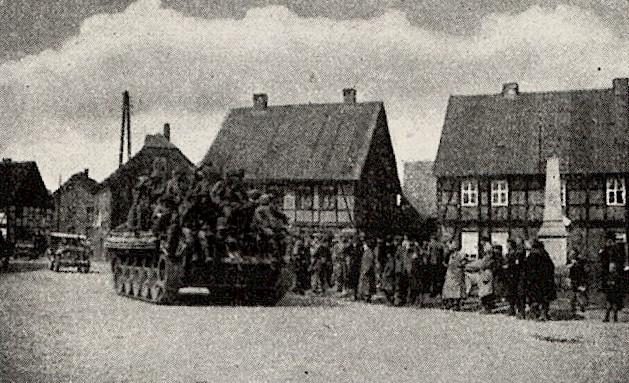 advance" line, which was in the vicinity of Hildesheim. The actual reason for this line being established is not known, although it was thought that the rapid advance had carried our forces into Russian territory. Major General Raymond S. McLain, XIX Corps Commander, was quoted as saying, "I do not know why General Simpson* established that line, but I presume it was
because of political reasons among the allies in Europe."1
To this point, XIX Corps had been attacking on a semi-narrow frontage and had had the 2d Armored Division in the left sector, followed by the 30th Division; while the 83d Division remained abreast of the 2d Armored's right flank. However, with the widening of the corps zone, switching the 30th Division from the rear
to the left flank of the 2d Armored was made necessary. At the same time, the 113th Cavalry Squadron was attached to the 83d Division and the 125th Cavalry Squadron to the 30th Division for the purpose of screening the advances of the respective divisions.2 With this arrangement, XIX Corps advanced toward the Elbe River. According to Corps Letter of Instructions #142, the 2d Armored was to seize a bridgehead across the Elbe and were then to assist the passage of the 30th and 83d Divisions through it.3 That that plan would not even begin to materialize will be seen later.
The 2d Armored Division made an 18 mile advance against the best coordinated effort exhibited by the Germans since the defense of the Teutorburger Wald. Combat Command A met considerable direct fire from dual-purpose 88mm guns and small arms fire in the factory area around Immendorf. CC B fighting a series of road block battles had by 1400, its forward elements within 6,000 yards of Hornburg.4
The enemy was forced to abandon the Herman Goering Works at Immendorf and the entire heavily built-up factory area southwest of Braunschweig. More than 60 88mm guns were destroyed as were Railroad guns and artillery of all calibers. Elements of CCA were forced to remain in the area after the enemy's evacuation on 11 April to prevent rioting, looting and traffic obstacles by the thousands of former forced laborers and freed Allied prisoners.
advance" line, which was in the vicinity of Hildesheim. The actual reason for this line being established is not known, although it was thought that the rapid advance had carried our forces into Russian territory. Major General Raymond S. McLain, XIX Corps Commander, was quoted as saying, "I do not know why General Simpson* established that line, but I presume it was
because of political reasons among the allies in Europe."1
To this point, XIX Corps had been attacking on a semi-narrow frontage and had had the 2d Armored Division in the left sector, followed by the 30th Division; while the 83d Division remained abreast of the 2d Armored's right flank. However, with the widening of the corps zone, switching the 30th Division from the rear
to the left flank of the 2d Armored was made necessary. At the same time, the 113th Cavalry Squadron was attached to the 83d Division and the 125th Cavalry Squadron to the 30th Division for the purpose of screening the advances of the respective divisions.2 With this arrangement, XIX Corps advanced toward the Elbe River. According to Corps Letter of Instructions #142, the 2d Armored was to seize a bridgehead across the Elbe and were then to assist the passage of the 30th and 83d Divisions through it.3 That that plan would not even begin to materialize will be seen later.
The 2d Armored Division made an 18 mile advance against the best coordinated effort exhibited by the Germans since the defense of the Teutorburger Wald. Combat Command A met considerable direct fire from dual-purpose 88mm guns and small arms fire in the factory area around Immendorf. CC B fighting a series of road block battles had by 1400, its forward elements within 6,000 yards of Hornburg.4
The enemy was forced to abandon the Herman Goering Works at Immendorf and the entire heavily built-up factory area southwest of Braunschweig. More than 60 88mm guns were destroyed as were Railroad guns and artillery of all calibers. Elements of CCA were forced to remain in the area after the enemy's evacuation on 11 April to prevent rioting, looting and traffic obstacles by the thousands of former forced laborers and freed Allied prisoners.
Miscellaneous units bore the entire weight of the advance. One significant fact emerging from this polyglot collection was the predominance of unite whose home stations ware in Wehrkreis VI, in which this fighting was taking place. This was the first instance when sizeable tactical units failed to appear from distant parts to help defend at successive points. Each locality was thus forced to rely on troops originally a part of that area, whether Volksturm, Service and Supply troops, or AA units.
The trucks, formerly utilized to motorize the 83d Division, had been returned to supply dumps, the day proceeding the issuance of this order, to replenish a now well depleted stock. The advance order came when trucks were not available, thus any and all transportation was gathered together.
Ahead lay the Harz Mountain area, which was known to be extremely rugged country. Not only was the natural growth and contours of the country an obstacle, but snow further made fighting conditions rough. The only effective enemy units were encountered in the northern approach to the Harz area south of Goslar, where our forces had to contend with elements of the 116th Panzer Division and 3d Panzer Grenadier Division that had managed to extricate themselves from the Ruhr Pocket. In addition, a newly formed division, the Potsdam, and a scratch division of Wehrkreis II, C. T. Greibig, made up the enemy forces.
As the 329th Regimental Combat Team, in the left half of the division sector and the 330th RCT in the right half, followed by the 331st RCT, surged ahead, resistance stiffened slightly along the edge of the woods northeast and southeast of Seesen, immediately in front of the 330th Combat Team. However, the 329th Combat Team continued driving around the northern edge of this area with very little difficulty and as the drive progressed, the 331st RCT was ordered to follow later swinging slightly south to take over the right half of the division sector. This was shortly done and both Combat Teams emerged on the slightly rolling but open country leading to their objective, the Elbe River. The 330th Combat Team was left with the responsibility of not only containing but eliminating the enemy in the northern Harz area.8
On 11 April the 2d Armored made the longest advance in one day that has probably been made in the European Theater. Elements of Combat Command B, having captured crossings of the Oker River intact, advance to the east in two columns meeting moderate resistance. The north column reached the outskirts of southern Magdeburg while the southern CLM reached [i.e., raced] approximately 67 miles and entered the town of Schonebeck that evening. Street fighting continued throughout the night, the river being reached the next morning although the bridge was blown at 12 0830 April.9 The 83d Division, still on the right flank of the 2d Armored Division, advanced almost as rapidly, clearing Halberstadt and Wegeleben against light resistance. On the other hand, the 30th Division was meeting stiffening resistance on the outskirts of Braunschweig.
12 April was a day of not only high hopes but hard fighting for all unite concerned. Enemy infantry offered determined resistance to CC A from roads east of Helmstedt, which had to be cleared before the advance could continue. Heavy artillery fire
was also received in large quantities from the towns lying to the northwest of Magdeburg.10 Elements of CC B received dual-purpose 88mm fire from the Wolfsfeld area where thirty planes were destroyed. Three of the latter were actually in the air when engaged by tanks of Combat Command B.11 Later that evening arrangements were made for the crossing of the Elbe River in the vicinity of Westerhusen.
The men of the 83d Division, feeling the effects of the break-through, were eager to continue, although practically at the point of exhaustion. On this hectic date, elements of this unit literally flew approximately 35 miles to reach the Elbe River, in the vicinity of Barby, using, as was noted, any and all types of transportation. The instructions to the 3d Battalion, 329th Infantry were to move straight through to the Elbe River as fast as possible, without bothering to clean out the sector thoroughly. The 1st Battalion was to follow along behind to attend to the cleaning up operation. The mission given to the 3d Battalion was to seize the railroad bridge at Barby and cross the river if possible. However, after having had only light resistance all the day, the 3d Battalion ran into a tough defensive line at the outskirt of Barby in the middle of the afternoon, and by nightfall it had only been able to gain a foothhold on the outskirts of the town. Click here for more on the Race to the ELBE
Surrender and Occupation
Once the 83rd crossed the Elbe River, there they were ordered by General Eisenhower to halt. They remained at the bridgehead until the final surrender of Germany on May 8, 1945. Once Germany surrendered, the 83rd moved to the Munich area and began Occupation duties. Soon word was out that the 83rd was selected as one of the divisions for the invasion of Japan, and training of the division began in earnest. The Division then remained in Germany for several months until the US dropped the Atomic Bombs on Japan and they surrendered. The Second World War was over and the GI's were going home. The division was disbanded in 1946, and remained a Reserve unit in Ohio until 1962 when it was officially decommissioned. The Thunderbolt division now lives on only in the memories of it's veterans and in history.
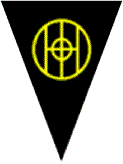
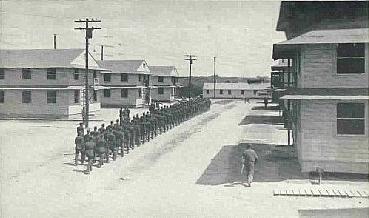 Induction
and Training: The Beginning
Induction
and Training: The Beginning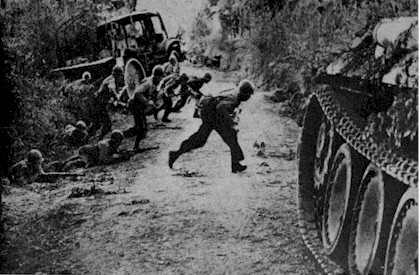 Normandy:
Baptism of Fire
Normandy:
Baptism of Fire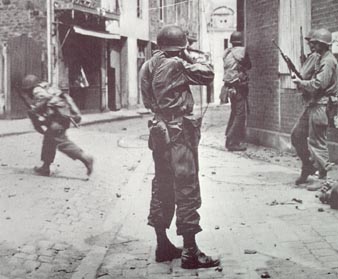 Brittany:
The conquest of St. Malo and Dinard
Brittany:
The conquest of St. Malo and Dinard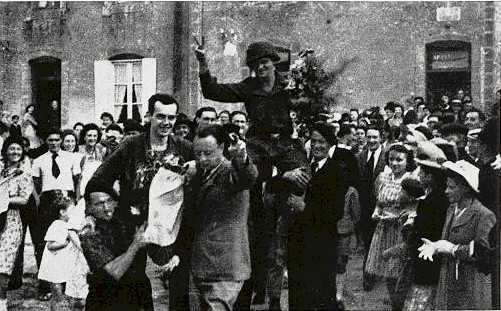 Loire
Valley and Luxembourg: Guarding Patton's Flank
Loire
Valley and Luxembourg: Guarding Patton's Flank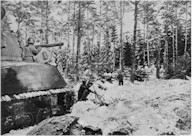 Huertgen
Forest and the Battle of the Bulge
Huertgen
Forest and the Battle of the Bulge Frostbite
and the Trip Home
Frostbite
and the Trip Home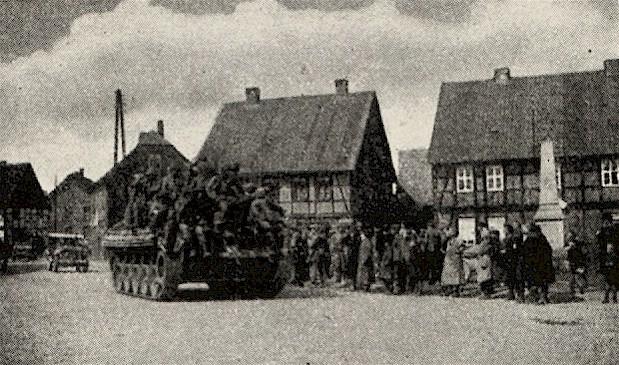 Germany:
The First to the Rhine and Crossing the Elbe
Germany:
The First to the Rhine and Crossing the Elbe They
Served with Honor : Home Page
They
Served with Honor : Home Page References,
Sources, and Links
References,
Sources, and Links